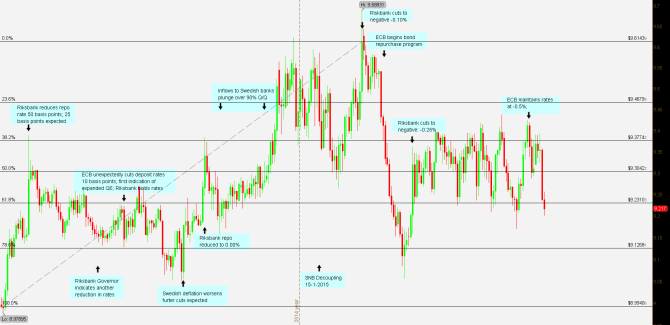In 18 June 2014, Sweden’s National Institute of Economic Research forecast continued low inflation and that Riksbank would need to cut its repo rate at least 0.50%, if not more. The report also noted that economic growth expectations would not exceed 2.2% for 2014. Sweden had been reaping the benefits of reduced taxes, to the point of 44% of GDP, lower than France. The same prosperity had made Sweden’s AAA sovereigns a sought after holding. However, household debt had also increased, housing prices were accelerating and income distribution was narrowing. Sweden had reached a crossroad as deflation was overtaking Europe.
Traders had been getting ahead of EUR/SEK on the growing expectations that Riksbank would have to act to support the export economy. It should be noted that the Krona had already weakened 5.5% over the previous six months. Recent surveys in France and Germany had indicated slowing economic growth. London Business School economist, Lucrezia Reichlin noted that, “…We aren’t seeing the type of recovery that we should be seeing given the scale of the slowdown .”‰.”‰. The data are not strong enough to tell us that we are even in a recovery..“
Guest post by Mike Scrive of Accendo Markets
An EU member summit 27 June discussed a more flexible interpretation of the Stability and Growth Pact, allowing members to undertake structural reforms independent of the EU. Prime Minister Matteo Renzi noted that “…If a country enacts serious structural reforms, it has the right to flexibility, which is the most important political point…”
Indeed, Riksbank was a step ahead and cut 50 basis on 3 July. Expectations were for a 25 basis point cut. EUR/SEK declined 1.41% in the day’s session. Riksbank’s Governor cited household debt as well as deflation concerns. On the same day as the Riksbank’s action, ECB President Mario Draghi stated that interest rates would be kept low for an ‘extended’ period of time.
The EUR/SEK stabilized after the Riksbank actions with support above kr9.1268 and resistance around kr9.2310. The GDP report released at the end of July indicated an economy growing at 1.9% vs the expectations of 2.4% annualized. It was around this time that the Ukraine conflict and Russian sanction threats were hampering growth in the Eurozone.
By mid-summer, incoming economic reports indicated continued slowing Eurozone growth . RB Governor Ingves responded by suggesting further reductions in rates, already at 25%; a clear suggestion of the willingness to ‘go negative’. This time, it was the ECB who surprised by cutting rates and announcing a greatly expanded bond purchase program. Although the data was far less than encouraging, Governor Ingves held the Swedish benchmark rate steady. By the middle of October the data was not encouraging, consumer prices declined more than expected and mortgage costs rose more than expected. Traders began to position for a cut and EUR/SEK jumped 1.2% in the 14 October session. Indeed, two weeks later, Riksbank went to zero.
It should be noted that ‘rate cut contagion’ was spreading throughout Europe and Asia, particularly in China, as growth continued to seek sustainability. This in turned caused Asian Pacific economies to increase cash liquidity within their own domestic economies. If Governors Ingves intended to weaken the Krona by rate reduction, he succeeded. Governor Ingves echoed Mario Draghi by stating that the central bank was “…prepared to take necessary measures“ in order to inflate the Krona. Inflows to Swedish banks declined to 4.4 billion Krona in Q3, down from 44.3 billion in the previous quarter. From 26 October through 26 December, the Krona weakened against the Euro nearly 3.4% to 9.5615 EUR/SEK.
As 2015 began, expectations for an expanded ECB QE were a near certainty, the Greek credit crises was becoming more serious and fighting raged in Ukraine. On the positive side, oil prices helped domestic spending in Europe. The confluence of events led to a strengthening of the Krona, but all of the past eight months efforts were undone by the Swiss National Bank decoupling from the Euro; the Krona corrected to 9.4205 per Euro. In early February, Denmark cut its benchmark to -0.75% in defense of its Euro peg. However on 12 February, the Krona reached its weakest point 9.68831 per Euro when Riksbank went negative, to -0.10%, in addition to a bond purchase program.
In spite of all of Mr. Ingves efforts, Riksbank was trumped by the unexpectedly large ECB QE bond purchasing program. EUR/SEK plummeted from the high of kr9.68831 to kr9.1048 in merely four weeks, a 6.03% decline. On 18 March, Riksbank unexpectedly expanded its QE and cut to -0.25% to reverse the strengthening Krona. Over the next three months, EUR/SEK traded mostly between 9.2310 support and 9.3774 resistance as bond markets unwound.
What’s to be expected? The EU economy and QE program dwarfs that of member Sweden. The ECB will have to unwind first, else capital will flow back into non-euro EU member economies. Further, the Greek crises is reaching a critical point. Should data indicate a continuance of deflation it will not bode well for the Euro against any pair, member or not.
Mike Scrive
“CFDs, spread betting and FX can result in losses exceeding your initial deposit. They are not suitable for everyone, so please ensure you understand the risks. Seek independent financial advice if necessary. Nothing in this article should be considered a personal recommendation. It does not account for your personal circumstances or appetite for risk.”
In our latest podcast we feature a Greferendum preview, NFP review and more
Follow us on Sticher.

